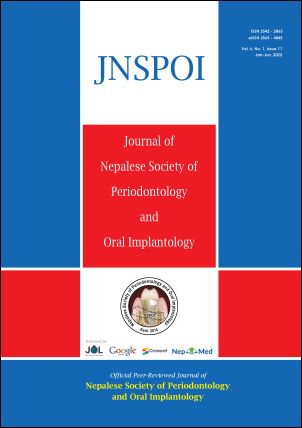Association of Bone Loss around Mandibular Second Molar and Impacted Third Molar: A Retrospective Study
DOI:
https://doi.org/10.3126/jnspoi.v6i1.52993Keywords:
Alveolar bone loss, mandibular second molar, mandibular third molar, orthopantomogram, retrospective studyAbstract
Introduction: Third molars that fail to attain a functional position may be associated with various pathological conditions in the adjacent tooth. In such areas, the maintenance of oral hygiene is difficult causing periodontal destruction to the adjacent second molars.
Objective: To determine the association between the alveolar bone loss in mandibular second molar and impacted third molar.
Methods: A retrospective analytical cross-sectional study was conducted from 2021 Sep 2 to 2021 Nov 2 after obtaining ethical approval from the Institutional Review Committee of Gandaki Medical College. Convenience sampling was done for 380 orthopantomograms of patients aged 18 years or older. Information on age, gender, bone loss in mandibular second molars, and type of third molar impactions were recorded. Data were analysed using SPSS v.16.0.
Results: Among observed radiographs, mesioangular impaction (224, 58.9%) was the commonest type followed by vertical impaction that was associated with alveolar bone loss in second molars. Alveolar bone loss in second molar teeth were more prevalent in males and age group of 21-30 years (199, 52.4%). There was a significant association between mesioangular impacted mandibular third molar and horizontal bone loss in adjacent second molars (P <0.05).
Conclusions: Awareness of the association between alveolar bone loss in mandibular second molars with impacted third molar helps in prevention and management of further complication due to such teeth. Thus, periodic clinical and radiographic examination is essential for patients with impacted teeth.
Downloads
Downloads
Published
How to Cite
Issue
Section
License
Copyright (c) 2022 Nepalese Society of Periodontology and Oral implantology (NSPOI)

This work is licensed under a Creative Commons Attribution 4.0 International License.
© Nepalese Society of Periodontology and Oral implantology (NSPOI)
Licenced by Creative Commons Attribution 4.0 International License.




